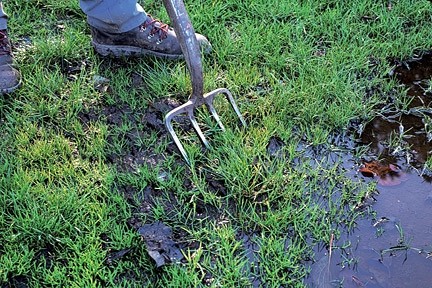Turf & Lawn Blog
Lawn Problems 10 - Waterlogged Lawn
Waterlogging in lawns is a problem which tends to show up in wet winters more than any other time of year. It is when the lawn does not drain at all, and water lies on the surface of the lawn after rain. Now, having a few puddles may not seem like too much of a problem in itself, but it does lead to other problems, such as compaction of soil. And if the water lies around for a long time, the grass can actually drown because the water prevents air getting to the roots, and then moss will take over, because it really likes damp conditions. A wet lawn also provides perfect growing conditions for algae and lichen. So, all round, it’s best to deal with waterlogging quickly and efficiently.
Waterlogging often happens on clay soils, because the soil gets very compacted very easily, especially if it’s wet. It can also happen if the soil was not properly prepared before the lawn was laid or seeded. If it’s in patches, it may be caused by a fungal disease, dry patch.

How to Fix Watter Logging in a Lawn
If your lawn suffers from waterlogging, then spiking, pricking and slitting the lawn can help.
- Pricking or slitting consists of making narrow, shallow holes to help the water drain away. It’s best to wait until the water has drained away, or brush it off onto the flower beds before doing this, as otherwise the holes you create will just fill straight up with water.
- Spiking deep holes is better, as the water drains away beyond the roots of the grass, and doesn’t risk drowning the lawn turf. You can either use a garden fork or a hollow tine aerator, which removes the soil from the holes. Fill the holes with a free-draining top dressing, such as sharp sand, or a proprietary lawn dressing. It’s best to spike every autumn, or at least every few years, to save having to do this as an emergency measure when your lawn is already waterlogged.
Overall, the best thing you can do is keep your lawn healthy and growing, and particularly encourage good strong root systems as this will make the lawn more resistant to both drought and flooding. Feed it regularly in spring and autumn with the correct fertiliser mixes for the season. Apply moss killer regularly to discourage moss from growing, especially in winter when the grass is less active.
As a last resort, as usual, the best thing to do is abandon your waterlogged lawn, dig it up and start again. Put down a 5cm deep bed of sharp sand, topped with a layer of topsoil mixed with manure or other organic matter, and then lay good quality turf on top.
When you subscribe to the blog, we will send you an e-mail when there are new updates on the site so you wouldn't miss them.
